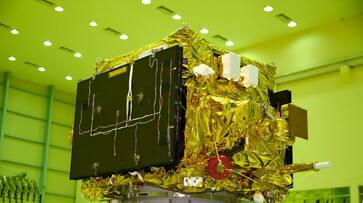Indian Space Reserach Organisation has developed HysIS, an earth observation satellite. It will be the the 45th flight of PSLV will be launched from the First Launch Pad of Satish Dhawan Space Centre, Sriharikota
Bengaluru: Indian Space Reserach Organisation (ISRO) is all set to launch its workhorse rocket PSLV-C43 carrying India's earth observation satellite HysIS and 30 co-passenger satellites, including 23 from the US, from Sriharikota on November 29.
The space agency said the 45th flight of PSLV will be launched from the First Launch Pad (FLP) of Satish Dhawan Space Centre (SDSC) SHAR, Sriharikota.
"HysIS is an earth observation satellite developed by ISRO. It is the primary satellite of the PSLV-C43 mission.
The satellite will be placed in 636 km polar sun synchronous orbit (SSO) with an inclination of 97.957 deg. The mission life of the satellite is 5 years," ISRO said.
According to the space agency, the primary goal of HysIS is to study the earth's surface in visible, near infrared and shortwave infrared regions of the electromagnetic spectrum.
The co-passengers of HysIS include one Micro and 29 Nano satellites from eight different countries, the agency said, adding, all these satellites will be placed in a 504 km orbit by PSLV-C43.
The countries comprise United States of America (23 satellites), Australia, Canada, Columbia, Finland, Malaysia, Netherlands and Spain (one satellite each).
These satellites have been commercially contracted for launch through Antrix Corporation Limited, the commercial arm of ISRO, the space agency said.
PSLV is ISRO's third generation launch vehicle. It can carry upto 1,750 kg of payload into polar SSO of 600 km altitude.
Additionally, PSLV has been used to launch planetary missions and also satellites into Geosynchronous Transfer Orbit, ISRO said.
ISRO launches in 2018
India's Polar Satellite Launch Vehicle, in its forty second flight (PSLV-C40), successfully launched the 710 kg Cartosat-2 Series Satellite for earth observation and 30 co-passenger satellites together weighing about 613 kg at lift-off. PSLV-C40 was launched from the First Launch Pad (FLP) of Satish Dhawan Space Centre (SDSC) SHAR, Sriharikota.
GSLV-F08 is the12th flight of Geosynchronous Satellite Launch Vehicle (GSLV) and Sixth flight with indigenous Cryogenic Stage. The Launch of GSLV-F08 carrying GSAT-6A took place from the Second Launch Pad (SLP) in Satish Dhawan Space Centre SHAR, Sriharikota. The Mission was launched on Thursday, March 29 at 4:56 PM.
India's Polar Satellite Launch Vehicle, in its forty-third flight (PSLV-C41) in XL configuration launched IRNSS-1I Satellite from First Launch Pad (FLP) of SDSC SHAR, Sriharikota. The 'XL' configuration of PSLV is used for the twentieth time. The IRNSS-1I is the eighth satellite to join the NavIC navigation satellite constellation.
It was launched on Thursday, April 12 at 4:04 AM (IST).
PSLV-C42 Launched two foreign satellites from Satish Dhawan Space Centre (SDSC), SHAR, Sriharikota on September 16. This mission was designed to launch two earth observation satellites, NovaSAR and S1-4 (together weighing nearly 889 kg) of M/s Surrey Satellite Technologies Limited (SSTL), United Kingdom under commercial arrangement with Antrix Corporation Limited, Department of Space. Both satellites were injected into 583 km Sun Synchronous Orbit.
GSLV MkIII-D2, the second developmental flight of GSLV MkIII successfully launched GSAT-29, a high throughput communication satellite at 5.08 pm on November 14, from the Second Launch Pad(SLP) at Satish Dhawan Space Centre SHAR, Sriharikota.
How will it benefit India?
HysIS will add a new dimension to plain-vanilla optical imagers. It is useful for various activities including monitoring the environment, crops, looking for oil and minerals and also military surveillance. HysIS will help have Hyperspectral imaging, or imaging spectroscopy, is what one gets when digital imaging and spectroscopy is combined. It can be used in getting great precision and detail into imageries. It enables distinct identification of objects, materials or processes on Earth by reading the spectrum for each pixel of a scene from space.
Thus, with more precision on these imageries, military surveillance will become strong. Also, it will help in formulating proper plans regarding agriculture, oil fields, minerals.
Last Updated Nov 28, 2018, 12:59 PM IST









![Salman Khan sets stage on fire for Anant Ambani, Radhika Merchant pre-wedding festivities [WATCH] ATG](https://static-gi.asianetnews.com/images/01hr1hh8y86gvb4kbqgnyhc0w0/whatsapp-image-2024-03-03-at-12-24-37-pm_100x60xt.jpg)
![Pregnant Deepika Padukone dances with Ranveer Singh at Anant Ambani, Radhika Merchant pre-wedding bash [WATCH] ATG](https://static-gi.asianetnews.com/images/01hr1ffyd3nzqzgm6ba0k87vr8/whatsapp-image-2024-03-03-at-11-45-35-am_100x60xt.jpg)


